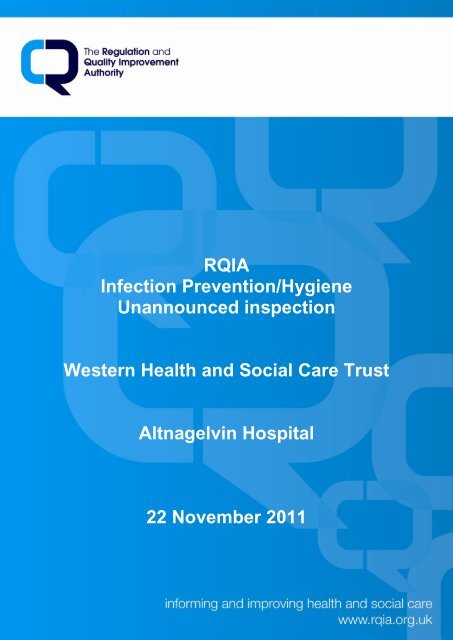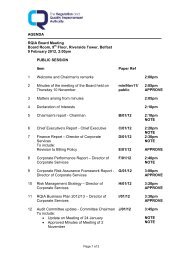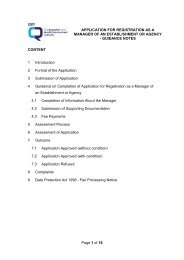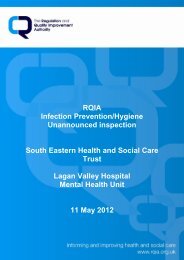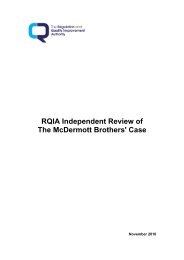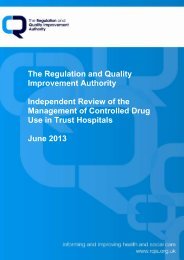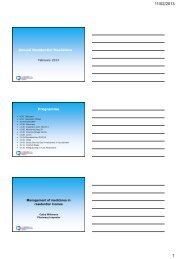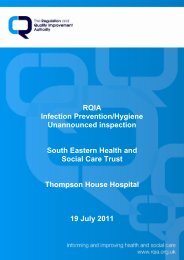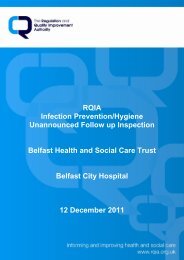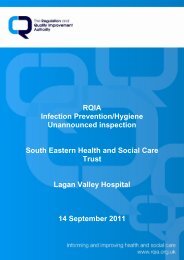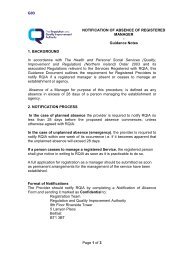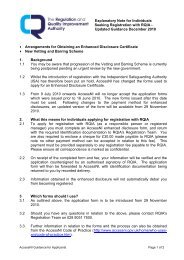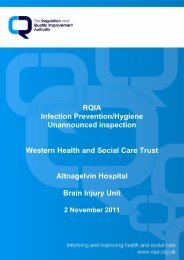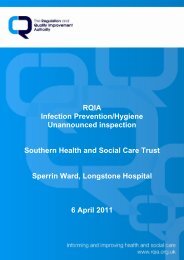Altnaglevin Hospital, Londonderry - 22 November 2011
Altnaglevin Hospital, Londonderry - 22 November 2011
Altnaglevin Hospital, Londonderry - 22 November 2011
You also want an ePaper? Increase the reach of your titles
YUMPU automatically turns print PDFs into web optimized ePapers that Google loves.
RQIA<br />
Infection Prevention/Hygiene<br />
Unannounced inspection<br />
Western Health and Social Care Trust<br />
Altnagelvin <strong>Hospital</strong><br />
<strong>22</strong> <strong>November</strong> <strong>2011</strong>
Contents<br />
1.0 Inspection Summary 1<br />
2.0 Background Information to the Inspection Process 6<br />
3.0 Inspections 7<br />
4.0 Unannounced Inspections 8<br />
4.1 Onsite Inspection 8<br />
4.2 Feedback and Report of the findings 8<br />
5.0 Audit Tool 9<br />
6.0 Environment 11<br />
6.1 Cleaning 12<br />
6.2 Clutter 14<br />
6.3 Maintenance and Repair 15<br />
6.4 Fixture and Fittings 15<br />
6.5 Information 16<br />
7.0 Patient Linen 18<br />
7.1 Management of Linen 18<br />
8.0 Waste and Sharps 20<br />
8.1 Waste 20<br />
8.2 Sharps 21<br />
9.0 Patient Equipment 23<br />
10.0 Hygiene Factors 25<br />
11.0 Hygiene Practice 28<br />
12.0 Key Personnel and Information 30<br />
13.0 Summary of Recommendations 31<br />
14.0 Unannounced Inspection Flowchart 33<br />
15.0 RQIA Hygiene Team Escalation Policy Flowchart 34<br />
16.0 Action Plan 35
1.0 Inspection Summary<br />
An unannounced inspection was undertaken to Altnagelvin <strong>Hospital</strong>,<br />
on the <strong>22</strong> <strong>November</strong> <strong>2011</strong>. The hospital was assessed against the<br />
Regional Healthcare Hygiene and Cleanliness standards and the<br />
following areas were inspected:<br />
Ward 3 - Respiratory<br />
Ward 8 - Orthopaedic<br />
Ward 31 - Planned Surgery<br />
Ward 40 - Stroke<br />
Altnagelvin Area <strong>Hospital</strong> is an acute hospital which offers a range of<br />
services, including a 24-hour Accident and Emergency Department.<br />
The hospital is currently undergoing a major redevelopment<br />
programme consisting of a new build and refurbishment of older wards.<br />
The main hospital building is made up of a tower block with a number<br />
of adjoining new extensions accommodating the outpatients<br />
department, day case unit, medical imaging, theatres, surgical wards,<br />
maternity ward, oncology unit, physiotherapy department. The wards<br />
inspected were a mix of new and old buildings, Ward 3 had just been<br />
refurbished and had only reopened the week before the inspection.<br />
Inspection Outcomes<br />
Overall the inspection teams found evidence that Altnagelvin Area<br />
<strong>Hospital</strong> is working to comply with the Regional Healthcare Hygiene<br />
and Cleanliness standards. However inspectors found that further<br />
improvement is required in the following areas.<br />
Wards, 3, 31 and 40 achieved an overall compliant score and Ward 8<br />
achieved an overall partially compliant score. Inspectors observed that<br />
the environment in the three wards which were compliant was<br />
generally clean and maintained to a satisfactory standard, however in<br />
Ward 8 more attention to detail was required when cleaning as a<br />
significant number of issues were identified for improvement.<br />
In Ward 8 three standards were minimally compliant, patient linen,<br />
sharps and patient equipment, and three standards were partially<br />
compliant, all require immediate action to reach an acceptable<br />
standard.<br />
In Wards 3, 31 and 40 the standard on patient equipment, and in<br />
Wards 3 and 40 the standard on safe handling and disposal of sharps<br />
were partially compliant which indicates that more work is required to<br />
improve practice.<br />
All wards were compliant in the segregation and storage of waste<br />
standard which is to be commended.<br />
1
As a result of the findings for Ward 8 a follow up inspection will be<br />
carried out within three months.<br />
The inspection resulted in 20 recommendations for Altnagelvin<br />
<strong>Hospital</strong>, a full list of recommendations is listed in Section 13.<br />
A detailed list of preliminary findings is forwarded to Western Health<br />
and Social Care Trust within 14 days of the inspection to enable early<br />
action on identified areas which have achieved non complaint scores.<br />
The draft report which includes the high level recommendations in a<br />
Quality Improvement Plan is forwarded within 28 days of the inspection<br />
for agreement and factual accuracy. The draft report is agreed and a<br />
completed action plan is returned to RQIA within 14 days from the date<br />
of issue. The detailed list of preliminary findings is available from RQIA<br />
on request.<br />
The final report and Quality Improvement Plan will be available on the<br />
RQIA website. Reports and action plans will be subject to performance<br />
management by the Health and Social Care Board and the Public<br />
Health Agency.<br />
Notable Practice<br />
The inspection identified the following areas of notable practice<br />
Domestic staff are trained to the British Institute of Cleaning<br />
Science standards (BICS)<br />
Both a patient on Ward 8 and a relative on Ward 40 spoke to<br />
the inspectors to praise the care given by staff on the ward<br />
The inspectors were informed that the hospital is<br />
commencing the Productive Ward Project in January 2012 1<br />
Waste is being recycled at ward level<br />
The RQIA inspection team would like to thank the staff at the<br />
Altnagelvin <strong>Hospital</strong> for their assistance during the inspection.<br />
The following tables give an overview of compliance scores noted in<br />
areas inspected by RQIA:<br />
Table 1 summarises the overall compliance levels achieved.<br />
Tables 2-7 summarise the individual tables for sections two to seven of<br />
the audit tool as this assists organisation to target areas that require<br />
more specific attention.<br />
1 Encourages nurses to make small changes to improve the way their ward is run by analysing the way they work<br />
2
Table 1<br />
Areas Inspected Ward 3 Ward 8 Ward 31 Ward 40<br />
General<br />
environment<br />
88 78 87 90<br />
Patient linen 95 68 82 90<br />
Waste 93 96 85 92<br />
Sharps 77 71 87 81<br />
Equipment 84 72 76 84<br />
Hygiene factors 93 84 95 91<br />
Hygiene practices 91 83 87 88<br />
Average Score 89 79 86 88<br />
Table 2<br />
General<br />
Environment Ward 3 Ward 8 Ward 31 Ward 40<br />
Reception N/A N/A 86 92<br />
Corridors, stairs lift 77 76 96 97<br />
Public toilets 94 N/A 88 N/A<br />
Ward/department -<br />
general<br />
88 76 97 93<br />
(communal)<br />
Patient bed area 77 71 81 85<br />
Bathroom/<br />
washroom<br />
96 76 86 94<br />
Toilet 93 86 87 95<br />
Clinical<br />
room/treatment 87 60 88 81<br />
room<br />
Clean utility room 87 75 84 N/A<br />
Dirty utility room 93 77 92 96<br />
Domestic store 98 89 98 91<br />
Kitchen 94 84 N/A 98<br />
Equipment store 96 78 67 77<br />
Isolation 78 86 92 93<br />
General<br />
information<br />
73 77 79 74<br />
Average Score 88 78 87 90<br />
Compliant:<br />
85% or above<br />
Partial Compliance: 76% to 84%<br />
Minimal Compliance: 75% or below<br />
3
Table 3<br />
Patient Linen Ward 3 Ward 8 Ward 31 Ward 40<br />
Storage of clean<br />
linen<br />
96 60 87 88<br />
Storage of dirty<br />
linen<br />
94 76 76 91<br />
Laundry facilities N/A N/A N/A N/A<br />
Average Score 95 68 82 90<br />
Table 4<br />
Waste and<br />
Sharps<br />
Handling,<br />
segregation,<br />
storage, waste<br />
Availability, use,<br />
storage of sharps<br />
Ward 3 Ward 8 Ward 31 Ward 40<br />
93 96 85 92<br />
77 71 87 81<br />
Table 5<br />
Patient<br />
Equipment<br />
Ward 3 Ward 8 Ward 31 Ward 40<br />
Patient equipment 84 72 76 84<br />
Table 6<br />
Hygiene Factors Ward 3 Ward 8 Ward 31 Ward 40<br />
Availability and<br />
cleanliness of<br />
wash hand basin<br />
82 91 99 96<br />
and consumables<br />
Availability of<br />
alcohol rub<br />
97 100 100 83<br />
Availability of PPE 100 85 85 100<br />
Materials and<br />
equipment for 93 61 95 83<br />
cleaning<br />
Average Score 93 84 95 91<br />
Compliant:<br />
85% or above<br />
Partial Compliance: 76% to 84%<br />
Minimal Compliance: 75% or below<br />
4
Table 7<br />
Hygiene<br />
Practices<br />
Ward 3 Ward 8 Ward 31 Ward 40<br />
Effective hand<br />
hygiene<br />
93 68 95 85<br />
procedures<br />
Safe handling and<br />
disposal of sharps<br />
91 85 91 100<br />
Effective use of<br />
PPE<br />
100 81 81 93<br />
Correct use of<br />
isolation<br />
95 N/A 93 80<br />
Effective cleaning<br />
of ward<br />
76 79 76 76<br />
Staff uniform and<br />
work wear<br />
93 100 90 93<br />
Average Score 91 83 87 88<br />
Compliant:<br />
85% or above<br />
Partial Compliance: 76% to 84%<br />
Minimal Compliance: 75% or below<br />
5
2.0 Background Information to the Inspection Process<br />
RQIA’s infection prevention and hygiene team was established to<br />
undertake a rolling programme of unannounced inspections of acute<br />
hospitals. The Department of Health Social Service and Public Safety<br />
(DHSSPS) commitment to a programme of hygiene inspections was<br />
reaffirmed through the launch in 2010 of the revised and updated<br />
version of 'Changing the Culture' the strategic regional action plan for<br />
the prevention and control of healthcare-associated infections (HCAIs)<br />
in Northern Ireland.<br />
The aims of the inspection process are:<br />
to provide public assurance and to promote public trust and<br />
confidence<br />
to contribute to the prevention and control of HCAI<br />
to contribute to improvement in hygiene, cleanliness and infection<br />
prevention and control across health and social care in Northern<br />
Ireland<br />
In keeping with the aims of the RQIA, the team will adopt an open and<br />
transparent method for inspection, using standardised processes and<br />
documentation.<br />
6
3.0 Inspections<br />
The DHSSPS has devised draft Regional Healthcare Hygiene and<br />
Cleanliness standards. RQIA has revised its inspection processes to<br />
support the publication of the standards which were compiled by a<br />
regional steering group in consultation with service providers.<br />
RQIA's infection prevention/hygiene team have planned a three year<br />
programme which includes announced and unannounced inspections<br />
in acute and non-acute hospitals in Northern Ireland. This will assess<br />
compliance with the DHSSPS Regional Healthcare Hygiene and<br />
Cleanliness standards.<br />
The inspections will be undertaken in accordance with the four core<br />
activities outlined in the RQIA Corporate Strategy, these include:<br />
Improving care: we encourage and promote improvements in the<br />
safety and quality of services through the regulation and review of<br />
health and social care<br />
Informing the population: we publicly report on the safety,<br />
quality and availability of health and social care<br />
Safeguarding rights: we act to protect the rights of all people<br />
using health and social care services<br />
Influencing policy: we influence policy and standards in health<br />
and social care<br />
7
4.0 Unannounced Inspection Process<br />
Trusts receive no advanced notice of the onsite inspection. An email<br />
and telephone call will be made by the Chief Executive of RQIA or<br />
nominated person 30 minutes prior to the team arriving on site. The<br />
inspection flow chart is attached in Section 14.<br />
4.1 Onsite Inspection<br />
The inspection team was made up of four inspectors, from RQIA’s<br />
infection prevention/hygiene team and four peer reviewers. One<br />
inspector led the team and was responsible for guiding the team and<br />
ensuring they were in agreement about the findings reached.<br />
Membership of the inspection team is outlined in Section 12.<br />
The inspection of ward environments is carried out using the Regional<br />
Healthcare Hygiene and Cleanliness audit tool. The inspection<br />
process involves observation, discussion with staff, and review of some<br />
ward documentation.<br />
4.2 Feedback and Report of the Findings<br />
The process concludes with a feedback of key findings to trust<br />
representatives including examples of notable practice identified during<br />
the inspection. The details of trust representatives attending the<br />
feedback session is outlined in Section 12.<br />
The findings, report and follow up action will be in accordance with the<br />
Infection Prevention/ Hygiene Inspection Process (methodology, follow<br />
up and reporting).<br />
The infection prevention/hygiene team escalation process will be<br />
followed if inspectors/reviewers identify any serious concerns during<br />
the inspection (Section 15).<br />
A number of documents have been developed to support and explain<br />
the inspection process. This information is currently available on<br />
request and will be available in due course on the RQIA website.<br />
8
5.0 Audit Tool<br />
The audit tool used for the inspection is based on the Regional<br />
Healthcare Hygiene and Cleanliness standards. The standards<br />
incorporate the critical areas which were identified through a review of<br />
existing standards, guidance and audit tools (Appendix 2 of Regional<br />
Healthcare Hygiene and Cleanliness standards). The audit tool follows<br />
the format of the Regional Healthcare Hygiene and Cleanliness<br />
Standards and comprises of the following sections.<br />
1. Organisational Systems and Governance: policies and<br />
procedures in relation to key hygiene and cleanliness issues;<br />
communication of policies and procedures; roles and<br />
responsibilities for hygiene and cleanliness issues; internal<br />
monitoring arrangements; arrangements to address issues<br />
identified during internal monitoring; communication of internal<br />
monitoring results to staff<br />
This standard is not audited when carrying out unannounced<br />
inspections however the findings of the organisational<br />
system and governance at annual announced inspection will<br />
be, where applicable, confirmed at ward level.<br />
2. General Environment: cleanliness and state of repair of public<br />
areas; cleanliness and state of repair of ward/department<br />
infrastructure; cleanliness and state of repair of patient bed area;<br />
cleanliness and state of repair of toilets, bathrooms and<br />
washrooms; cleanliness and state of repair of ward/department<br />
facilities; availability and cleanliness of isolation facilities;<br />
provision of information for staff, patients and visitors<br />
3. Patient Linen: storage of clean linen; handling and storage of<br />
used linen; ward/department laundry facilities<br />
4. Waste and Sharps: waste handling; availability and storage of<br />
sharps containers<br />
5. Patient Equipment: cleanliness and state of repair of general<br />
patient equipment<br />
6. Hygiene Factors: hand wash facilities; alcohol hand rub;<br />
availability of personal protective equipment (PPE); availability of<br />
cleaning equipment and materials.<br />
7. Hygiene Practices: hand hygiene procedures; handling and<br />
disposal of sharps; use of PPE; use of isolation facilities and<br />
implementation of infection control procedures; cleaning of<br />
ward/department; staff uniform and work wear<br />
9
Level of Compliance<br />
Percentage scores can be allocated a level of compliance using the<br />
compliance categories below. The categories are allocated as follows:<br />
Compliant<br />
85% or above<br />
Partial compliance 76 to 84%<br />
Minimal compliance 75% or below<br />
Each section within the audit tool will receive an individual and an<br />
overall score, to identify areas of partial or minimal compliance to<br />
ensure that the appropriate action is taken.<br />
10
6.0 Environment<br />
STANDARD 2.0<br />
GENERAL ENVIRONMENT<br />
Cleanliness and state of repair of public areas; cleanliness and<br />
state of repair of ward/department infrastructure; cleanliness and<br />
state of repair of patient bed area; cleanliness and state of repair<br />
of toilets, bathrooms and washrooms; cleanliness and state of<br />
repair of ward/department facilities; availability and cleanliness of<br />
isolation facilities; provision of information for staff, patients and<br />
visitors.<br />
General<br />
Environment<br />
Ward 3 Ward 8 Ward 31 Ward 40<br />
Reception N/A N/A 86 92<br />
Corridors, stairs<br />
lift<br />
77 76 96 97<br />
Public toilets 94 N/A 88 N/A<br />
Ward/department<br />
- general<br />
88 76 97 93<br />
(communal)<br />
Patient bed area 77 71 81 85<br />
Bathroom/<br />
washroom<br />
96 76 86 94<br />
Toilet 93 86 87 95<br />
Clinical<br />
room/treatment 87 60 88 81<br />
room<br />
Clean utility room 87 75 84 N/A<br />
Dirty utility room 93 77 92 96<br />
Domestic store 98 89 98 91<br />
Kitchen 94 84 N/A 98<br />
Equipment store 96 78 67 77<br />
Isolation 78 86 92 93<br />
General<br />
information<br />
73 77 79 74<br />
Average Score 88 78 87 90<br />
The above table outlines the findings in relation to the general<br />
environment of the facilities inspected. The findings indicate that there<br />
are concerns regarding Ward 8 and in particular the minimally<br />
compliant areas highlighted in red. The findings in respect of the<br />
general environment are detailed in the following sections.<br />
11
6.1 Cleaning<br />
During the inspection there was evidence to indicate compliance with<br />
regional specifications for cleaning. However, inspectors observed,<br />
that while cleaning mechanisms were in place to prevent the build up of<br />
dust, debris and bacteria and subsequently minimise the potential risk<br />
for the transmission of infection, these were not always effectively<br />
implemented or adhered to by staff.<br />
The team inspected the two receptions areas, the main reception which<br />
is part of the old hospital and the entrance to the new wing. The main<br />
reception had no cleaning issues except for the fabric finish of the<br />
chairs which were stained. In contrast the outside of the reception of<br />
the new wing was littered with discarded cigarettes butts and grass<br />
was growing up through the paving. The glass entrance doors were<br />
very soiled and the overhead external glass ceiling was partly covered<br />
in green moss (Picture1). The disabled door access button was<br />
marked and required cleaning.<br />
Picture 1: Glass in new reception area<br />
Overall the of cleaning in Ward 3, 31 and 40 was of a good standard.<br />
In Ward 31 more attention was required to cleaning areas such as floor<br />
corners and behind bins, which were dusty. The wall behind the sink in<br />
the clean utility room, the door frame of the dirty utility room and the<br />
frame of a patient bed were stained. In the sanitary areas, the frame of<br />
the shower chair, in the bathroom was stained and in the toilet the<br />
underside of the raised toilet seat was stained and the framework was<br />
rusted. Both the inside of a toilet bowl and the sluice hopper in the<br />
dirty utility room required cleaning.<br />
Ward 3 had only been re-opened for a week after refurbishment and<br />
some surfaces such as the patients’ bedside table and computer key<br />
boards were dusty. In the dirty utility room there was paper debris in<br />
the high density storage units and adhesive residue on the glass panel<br />
of the door. There was a fabric finished chair in the treatment room,<br />
this is not suitable for clinical areas as it cannot be effectively cleaned.<br />
The bathroom was being used to store a hoist and 2 slings, there was<br />
12
also evidence of communal products such as toothpaste, talcum<br />
powder, shower gel and E45 cream.<br />
Patients should be discouraged from leaving their soaps and shower<br />
gels in the shower and on the wash hand basins. This will prevent the<br />
use of communal products and help to reduce the risk of contamination<br />
and possible spread of infection.<br />
In Ward 40 some bed frames were dusty, this included one which had<br />
been marked as cleaned on the 21 <strong>November</strong> <strong>2011</strong>. A baby bath<br />
cleansing solution and talcum powder had been left on the hand<br />
washing sink in the bathroom and in the shower room, communal<br />
toiletries and a tube of Tena cream wash were observed. The floor<br />
and shelves in the equipment store were dusty, the room was cluttered<br />
and untidy restricting effective cleaning, an issue also identified in<br />
Ward 31.<br />
In all four wards particular attention was required when cleaning<br />
isolation rooms. In Ward 3, which had just been refurbished, the<br />
flooring in Room H, had ground in stains, the top of the bedside table<br />
was dusty and the laminate finish was damaged. The undercarriage of<br />
the bed was dusty and there was minor damage to the frame. The<br />
fabric of an armchair was torn, therefore the chair could not be<br />
effectively cleaned and there were stains on the newly painted ceiling.<br />
The room was cluttered with patients property, electrical equipment<br />
and respiratory equipment, all of which prevent effective cleaning. In<br />
Wards 8, 31 and 40, the floor required cleaning and in Ward 31 the<br />
underside of the raised toilet seat and the top of the shower chair in the<br />
en-suite were stained.<br />
The inspectors noted three minimally compliant sections in Ward 8; the<br />
bed area, clinical room and clean utility room, (which was a joint<br />
examination and pharmacy room). The inspectors acknowledge that<br />
this ward is in the older part of the hospital and there are estates issues<br />
associated with age which have had a negative impact on some of the<br />
score, however cleaning issues were identified. The floor of bed Bay D<br />
and F, had ground in stains and the floor at the corners and under the<br />
beds was dusty. The top of the bedside tables required cleaning and<br />
bedside chairs were dusty, stained and showing signs of wear. The<br />
undercarriage of some beds and wall shelving were also dusty. In the<br />
treatment room there were stains on the external cupboard doors and<br />
the medical gas alarm.<br />
The ceiling light fitting and air vents were dusty, and there was<br />
adhesive residue on the glass panel of the door. The plug, taps and<br />
overflow on the hand washing sink at the nurses’ station were dirty, the<br />
outside of the drugs fridge was stained, damaged, the door was not<br />
locked. The window blinds in the examination room were broken and<br />
dusty and the high density shelving in the pharmacy was dusty. The<br />
foot stools in the clinical room and clean utility room required cleaning.<br />
13
The sanitary areas also had cleaning issues; in the toilets the rim of the<br />
toilet bowl and underneath the raised toilet seat were stained, the<br />
frame of the raised toilet seat was dirty and rusty. The underside of the<br />
taps of the hand washing sink required cleaning. In the bottom shower<br />
room the seal and the edge of the shower door and the shower curtain<br />
were stained; there was mould present in the shower base. The<br />
underside of the toilet seat, the rim of the toilet bowl, and the underside<br />
of the raised seat were all stained.<br />
In both Ward 8 and Ward 31<br />
inspections of bed mattresses<br />
showed that the vinyl covers<br />
and the foam interior were<br />
stained, in Ward 8 a mattress<br />
had a tear and in Ward 31 the<br />
cover had perished (Picture<br />
2).<br />
Picture 2: Ward 31 perished cover on mattress<br />
In all four wards the temperature of the drugs fridge was not recorded<br />
consistently. It is advised that fridge temperature checks are carried<br />
out on a daily basis to ensure medication is kept at the correct<br />
temperature and to identify if a fridge has failed to reach the required<br />
temperature and a cold chain failure has occurred.<br />
Throughout the four wards inspected it was observed that the external<br />
windows were dirty and that there was limescale present on some taps.<br />
6.2 Clutter<br />
The main ward areas of Wards 3, 8 and 40 were cluttered with a mix of<br />
patient equipment, cages, mattresses, mobile vital signs trolleys, linen<br />
trolleys, notes and drugs trolleys. Inspectors noted that with the<br />
exception of Ward 8 the ward areas became less cluttered as the<br />
morning progressed.<br />
The isolation room in Ward 3, as highlighted in the cleaning section<br />
was cluttered, and there was no wardrobe for the patient’s personal<br />
belongings. The linen store of Ward 8 was cluttered in appearance.<br />
Equipment such as wheelchair feet and pressure relieving/support<br />
wedges were stored on shelves. Three mattresses, patient handling<br />
equipment and resuscitation training equipment were either stored on<br />
the floor or were hanging from hooks in the linen store wall.<br />
The equipment stores in Wards 31 and 40 and the treatment room of<br />
Ward 40, were cluttered and untidy with excess equipment, the rooms<br />
had a multi purpose function which needs to be clearly defined.<br />
14
Additional Issue<br />
In Ward 8 the lift lobby used to transport patients to theatre was<br />
cluttered and untidy with waste bins and broken equipment. The<br />
inspectors observed a patient going to theatre being wheeled through<br />
this area; this does not promote a good public perception of the ward<br />
environment. From a patient’s perspective going to theatre through a<br />
cluttered service corridor is not conducive to providing a relaxed,<br />
reassuring experience.<br />
6.3 Maintenance and Repair<br />
In all wards there was some damage to walls, doors, flooring, paint and<br />
laminate finishes. In Ward 3, which had just been refurbished, the<br />
walls had been painted but there were still holes in the wall where<br />
fittings had been removed and not been replaced or the holes repaired.<br />
Damaged electrical sockets were noted behind a bed in bed Bay L.<br />
In Ward 40 there was a small gouged hole in the floor of bed Bay B<br />
approximately one inch deep, thus this section of the flooring could not<br />
be effectively cleaned and it was not impervious to moisture. In the<br />
domestic store there was some minor paintwork damage and perished<br />
plaster causing a hole in the wall under the equipment sink; the<br />
damage was previously caused by a leak in the pipework behind the<br />
wall. On inspection of the pipework a dripping sound was heard and<br />
the domestic stated that the leak has recurred. The tiled floor in the<br />
dirty utility room had been repaired, sections of the floor had been replastered,<br />
however this was rough and unsealed, therefore unable to<br />
be effectively cleaned.<br />
The bedpan washers in Ward 8 and Ward 40 were out of order. In<br />
Ward 31 staff said the bedpan washer was not washing effectively and<br />
they were therefore carrying out a manual bedpan pre-wash. The<br />
maintenance and repair of the bedpans washers should be actioned as<br />
a matter of urgency.<br />
6.4 Fixtures and fittings<br />
The chairs in the main entrance were finished in a washable fabric,<br />
however they were showing signs of wear. There were also two large<br />
A&E porter chairs, the arm of one had been repaired with masking tape<br />
and the frame of the other was damaged. Chairs in Wards 3 and 8<br />
were also noted to be worn and in Ward 3, 31 and 40 the bedframes<br />
were chipped or damaged.<br />
In Ward 3 some of the curtains had shrunk and the toilet roll holder in<br />
the public toilet and in a patient ward toilet was broken, the drip tray for<br />
the bedpan rack was missing. In Ward 8 the toilet roll dispenser in the<br />
shower room was also broken, there was no bedpan rack or tray and<br />
the frame of the raised toilet seat was rusty.<br />
15
Picture 4: Ward 40 damaged frame<br />
of food service trolley<br />
There was a shortage of bed<br />
screens in Ward 40 and the<br />
ward sister informed the<br />
inspectors that it is difficult to<br />
find sufficient replacement<br />
curtains especially after<br />
patient discharge. Also the<br />
kitchen tray trolley was old,<br />
worn and very damaged; it<br />
should be replaced as it can<br />
not be effectively cleaned<br />
(Picture 4).<br />
In Wards 3, 8 and 40 the notice boards were finished in felt material<br />
which can not be effectively cleaned.<br />
Additional issue<br />
In Ward 40 the inspectors noted that the patient call bell was located at<br />
the opposite side to where the patient chairs were positioned, the cord<br />
of the call bell in use was not long enough to reach to the other side of<br />
the bed.<br />
6.5 Information<br />
Cleaning schedules were available for nursing staff in all four wards,<br />
however they lacked detail in outlining staff roles and responsibilities<br />
for cleaning at ward level. Information posters on waste handling, linen<br />
segregation, NPSA colour coding of cleaning equipment and<br />
management of inoculation injury were not available consistently in all<br />
wards. In Ward 31 some of the posters in the clean utility room were<br />
old and torn. Information leaflets on MRSA and Clostridium-difficile<br />
were not available in Ward 8 or Ward 40, however the ward sister did<br />
say they could be printed from the internet as required.<br />
There were no hand hygiene posters at all of the hand washing sinks in<br />
either Ward 3 or 40 and Ward 40 did not have any advice leaflets on<br />
hand hygiene available. Not all the information posters which were<br />
displayed in Wards 3 and 40 were laminated and in Ward 40 some<br />
were attached to cupboards with adhesive tape. At the entrance to<br />
Ward 40, seven poster type pages had been attached to the door,<br />
some were not laminated, some were duplicated; the need for all these<br />
posters should be reviewed.<br />
Recommendations<br />
1. The trust should ensure that the systems and processes in<br />
place for environmental cleaning, provide the necessary<br />
16
assurance that cleaning is carried out effectively, and that all<br />
staff are aware of their responsibilities.<br />
2. The healthcare environment should be repaired and<br />
maintained, and damaged fixtures and fittings replaced to<br />
maintain public confidence and to help reduce the risk of the<br />
spread of infection.<br />
3. Work should continue on improving storage and maintaining<br />
clutter free environments.<br />
4. Detailed nursing cleaning schedules should be developed.<br />
5. The trust should ensure that all staff are aware of the<br />
importance of monitoring fridge temperatures.<br />
6. An agreed set of core HealthCare Associated Infection (HCAI)<br />
public information leaflets should be available for patients,<br />
visitors, and staff.<br />
17
7.0 Patient Linen<br />
STANDARD 3.0<br />
PATIENT LINEN<br />
Storage of clean linen; handling and storage of used linen; ward/<br />
department laundry facilities.<br />
Patient Linen Ward 3 Ward 8 Ward 31 Ward 40<br />
Storage of clean<br />
linen<br />
96 60 87 88<br />
Storage of used<br />
linen<br />
94 76 76 91<br />
Laundry facilities N/A N/A N/A N/A<br />
Average Score 95 68 82 90<br />
7.1 Management of Linen<br />
Ward 3 and Ward 40 achieved an overall compliance score in this<br />
standard, which is to be commended. Overall Ward 31 was partially<br />
compliant and Ward 8 was minimally compliant.<br />
Picture 3: Ward 8 Untidy and<br />
cluttered linen store<br />
In Ward 8, the inspectors observed that<br />
the linen store was untidy, cluttered and<br />
over stocked (Picture 3). The ward had<br />
received a linen delivery on the<br />
morning of inspection; the delivery man<br />
had placed the wrapped clean linen<br />
bags on the floor of the linen store.<br />
Ward staff subsequently tidied the linen<br />
store however a bag of sheets<br />
remained on the floor. The store was<br />
also used to store patient equipment<br />
such as mattresses, pressure relieving<br />
supports, resuscitation and patient<br />
handling equipment; the windowsill was<br />
used to store patient pillows. The clutter<br />
made access for cleaning difficult as<br />
skirting, floors and windowsill all<br />
required cleaning.<br />
A similar issue regarding the level of stock was observed in Ward 31.<br />
The store was neat and tidy, but the shelves were not all filled, and it<br />
was noted that the stock was mainly curtains. The ward was storing<br />
linen in small cabinets which were located in one of the main corridors<br />
in public view. The cabinets which also stored incontinence products<br />
did not have doors or protective covers, both the linen and incontinence<br />
pads had been removed from their packaging and were exposed to<br />
18
potential airborne contamination. The room was also being used to<br />
store a bed bumper which was dirty; the floor vinyl was damaged.<br />
Ward 3 linen store also had inappropriate items stored in the room. A<br />
mattress was stored on the floor and the windowsill was cluttered with<br />
a zimmer frame, scourers, green wipes, detergent wipes, cardboard<br />
boxes and bottles of detergent. Ward 4 had patient property bags<br />
stored beside clean linen.<br />
In the section on used linen, Ward 3 and Ward 40 were compliant. The<br />
only issue was in relation to the state of the used linen bags which<br />
were noted to be torn or damaged.<br />
The used linen bags in Ward 31 were overfilled and none of the staff<br />
were wearing gloves and aprons, personal protective equipment (PPE),<br />
when engaged in handling used linen. Staff in Ward 8 had placed used<br />
linen on top of a linen skip and filled linen bags were observed in the<br />
corridor. In relation to practice observed, staff were carrying used linen<br />
to the skips rather than bringing the linen skip to the point of use at the<br />
bedside. A member of staff was observed entering the linen room, mid<br />
patient procedure to retrieve a towel while wearing PPE.<br />
Recommendations<br />
7. A review of the linen stores should be carried out to ensure<br />
clean linen is stored under appropriate conditions.<br />
8. Staff should ensure linen and associated items are fit for<br />
purpose.<br />
9. Staff should wear PPE as per trust guidelines.<br />
19
8.0 Waste and Sharps<br />
STANDARD 4.0<br />
WASTE AND SHARPS<br />
Waste: Effectiveness of arrangements for handling, segregation,<br />
storage and disposal of waste on ward/department<br />
Sharps: Availability, use and storage of sharps containers on<br />
ward/department<br />
Waste and<br />
Sharps<br />
Handling,<br />
segregation,<br />
storage, waste<br />
Availability, use,<br />
storage of sharps<br />
Ward 3 Ward 8 Ward 31 Ward 40<br />
93 96 85 92<br />
77 71 87 81<br />
8.1 Waste<br />
In this standard all four wards were compliant in the section which<br />
related to the handling, segregation and storage of waste. Inspectors<br />
noted in all four wards the magpie box was being used for the disposal<br />
of pharmaceutical waste and in Ward 31, the black lidded burn bin<br />
which is used for the disposal of pharmaceutical waste was over<br />
flowing with tubing protruding. The box was replaced during the<br />
inspection.<br />
Paper waste was inappropriately disposed of into clinical waste bins in<br />
both Wards 3 and 8. In Ward 40 there was no household waste bin in<br />
the dirty utility room and the bin in a bed bay was overfilled. Waste<br />
bins in the dirty utility room and staff room in Ward 40 and in a bed bay<br />
and treatment room in Ward 31 were stained and rusty.<br />
In Ward 3 the household waste bin in Room H was not easily<br />
accessible and in some bays clinical waste bins were located beside<br />
the hand washing sinks, which can encourage inappropriate disposal of<br />
non-clinical waste.<br />
20
The lift lobby in Ward 8 was<br />
being used to store large euro<br />
waste bins (Picture 4) rather<br />
than the designated disposal<br />
area. In Ward 31 the<br />
disposal room for waste and<br />
the yellow cupboard in the<br />
disposal room for the safe<br />
storage of sharps boxes were<br />
not locked.<br />
8.2 Sharps<br />
Picture 4: Ward 8 Lift lobby area<br />
In the section which related to the safe handling and disposable of<br />
sharps only Ward 31 was compliant, Wards 3 and 40 were partially<br />
compliant and Ward 8 was minimally compliant.<br />
In all of the wards the inspectors noted that not all the temporary<br />
closure mechanisms on the sharps boxes were in place. At Ward 3,<br />
nurses station, Ward 8 clinical room, and Ward 31 clean utility room,<br />
the sharps boxes were not secured by wall brackets and the door to the<br />
rooms were open to the public. With the exception of Ward 31 and<br />
Ward 3, sharps boxes were not signed or dated, however in Ward 3 the<br />
black and yellow lidded burn bins were not signed or dated and the lid<br />
of the black burn bin was not secured.<br />
In Ward 40, the sharps box on the resuscitation trolley was dated<br />
August <strong>2011</strong>, it was not secured and had been used.<br />
Compatible sharps trays for the 2.5L sharps boxes were not available<br />
in Ward 3. Staff were using aseptic non touch technique (ANTT) trays<br />
and the 0.5L rectangle sharps boxes to carry clinical equipment. When<br />
questioned staff confirmed the 0.5L boxes were too small to hold<br />
intravenous equipment needed for certain procedures. Sister<br />
confirmed the trays had been lost in transit during the ward decant and<br />
a representative from the sharps box supplier was coming to the ward<br />
this week with replacement sharps trays.<br />
The inspectors in Ward 8 observed a syringe plunger protruding from a<br />
sharps box in the clinical room, the lid of a sharps box was dusty and<br />
the sharps box on the resuscitation trolley was not secured. They also<br />
noted one of the sharps trays was dirty and another was cracked and<br />
dirty.<br />
21
Recommendations<br />
10. Waste bins and equipment used in the management of waste<br />
should be available, clean and free from damage.<br />
11. The trust should monitor the implementation of its policies<br />
and procedures in respect of the management of waste and<br />
sharps to ensure that safe and appropriate practice is in<br />
place.<br />
<strong>22</strong>
9.0 Patient Equipment<br />
STANDARD 5.0<br />
PATIENT EQUIPMENT<br />
Cleanliness and state of repair of general patient equipment.<br />
Patient<br />
Equipment<br />
Ward 3 Ward 8 Ward 31 Ward 40<br />
Patient Equipment 84 72 76 84<br />
Improvement is required across all wards with regard to the<br />
cleanliness, state of repair of patient equipment and staff practice.<br />
Ward 3 and Ward 40 were partially compliant, Ward 31 had a low<br />
partial compliance score and Ward 8 was minimally compliant.<br />
Trust staff use a system of green trigger tape to indicate that equipment<br />
has been cleaned. The inspectors found in Wards 3 and 31 that while<br />
tape was in place equipment was not clean. In Ward 3 the portable<br />
nebuliser in room L was very dirty, especially in the crevices of the<br />
handle. This piece of equipment had tape attached indicating it had<br />
been cleaned on the 19 <strong>November</strong> <strong>2011</strong>.<br />
A commode with tape in Ward 31 was heavily stained and a BP<br />
monitor stand in use was dusty and had trigger tape attached dated<br />
July <strong>2011</strong>. The use of trigger tape was not consistent in Ward 8, two<br />
commodes checked had no trigger tape and not all stored IV stands<br />
had tape insitu. In all four wards, dust and sticky tape was noted on<br />
portable equipment such as IV stands, ECG, suction machines,<br />
resuscitation trolleys and dressing trolleys.<br />
In both Ward 3 and Ward 31 there was no tracking system for reusable<br />
hoist slings to indicate which patient was using the sling. The slings<br />
were stored over the hoist in the shower room in Ward 3 and over the<br />
hoist stored in the corridor of Ward 31.<br />
In Ward 40, Ward 31, and Ward 3 the ambu bag had been removed<br />
from the original packaging, and in Ward 8 the laryngoscope blade had<br />
also been removed from its’ packaging. In Ward 3, three nasal tubes<br />
with a pin attached were stored out of packaging in a drawer of the<br />
resuscitation trolley. The Association of Anaesthetist of Great Britain<br />
and Ireland guidelines "Infection Control in Anaesthesia "states that<br />
single use resuscitation equipment should be kept in a sealed package<br />
or should be re-sterilised between patients according to manufacturer's<br />
instructions. It also states that packaging should not be removed until<br />
the point of use for infection control, identification, traceability in the<br />
case of a manufacturer's recall and safety.<br />
23
Damaged equipment was noted in all wards. In Ward 3 bedpans in the<br />
dirty utility room and IV stands in the store were old and worn. The<br />
frames of some commodes were rusted, the frame of the notes trolley<br />
was chipped and the legs of the trolley holding the ECG machine were<br />
damaged. The top of the resuscitation trolley in Ward 40 was damaged<br />
and in Ward 31 the catheter stands in the dirty utility room had been<br />
bound in fabric bandage and the plastic coating was split in places.<br />
There were several issues identified by the inspectors in Ward 8<br />
regarding staff practice. The inspectors were advised by staff in Ward<br />
8 that patients anti – embolism stockings (TEDS) were communally<br />
soaked in Daz washing powder and dried in the ward tumble dryer.<br />
Both a nasal cannulae and a detached IV line were observed hanging<br />
loosely from an oxygen point at the patients bedside and IV stand<br />
respectively. The tip of the IV line was uncovered. When questioned<br />
staff gave varying answers on when to change oxygen/nebulizer tubing<br />
and equipment.<br />
In Ward 8, the inspectors observed one patient being assisted with<br />
personal care, the bedside locker was open and clothing/underwear<br />
had spilled on to the floor. Both a bedpan and urinal had not been<br />
emptied after use and were left underneath the bed on the floor for<br />
some time. A doctor was also observed handling the tip of a syringe<br />
prior to use as part of an aseptic non touch (ANTT) procedure.<br />
With the exception of the staff on Ward 3, staff were not aware of the<br />
symbol for single use items.<br />
Recommendations<br />
12. The trust has and individual staff and a collective<br />
responsibility to ensure that patient equipment is clean and<br />
in good repair.<br />
24
10.0 Hygiene Factors<br />
STANDARD 6.0<br />
HYGIENE FACTORS<br />
Hand wash facilities; alcohol hand rub; availability of PPE;<br />
availability of cleaning equipment and materials.<br />
Hygiene Factors Ward 3 Ward 8 Ward 31 Ward 40<br />
Availability and<br />
cleanliness of<br />
WHB and<br />
82 91 99 96<br />
consumables<br />
Availability of<br />
alcohol rub<br />
97 100 100 83<br />
Availability of PPE 100 85 85 100<br />
Materials and<br />
equipment for 93 61 95 83<br />
cleaning<br />
Average Score 93 84 95 91<br />
Three wards achieved an overall compliance score, with Ward 31<br />
achieving compliance in all four sections, staff should be commended.<br />
The only section that was minimally compliant was in Ward 8, materials<br />
and equipment for cleaning.<br />
In the first section, the only issue identified in Ward 31 was in relation<br />
to the overflow in the dirty utility room which was dirty. Common areas<br />
for attention in Wards 3, 8 and 40 were some soap and towel<br />
dispensers required cleaning and some required repair. In Ward 8 dirty<br />
utility room the hand washing consumables were situated at the<br />
equipment sink rather than at the hand washing sink for staff to access.<br />
In Ward 8 dirty utility room the hand washing sink had a plug and<br />
overflow and the taps were wrist operated rather than sensor or elbow<br />
operated. There were similar issues in Bays L, K and the dirty utility<br />
room in Ward 3 regarding taps, overflows and plugs. In addition in<br />
Ward 3 the sink in the treatment room was not accessible and was<br />
cluttered with packages containing sterile supplies.<br />
With regard to availability of alcohol rub, Wards 8 and 31 were fully<br />
compliant. In Ward 3 a portable alcohol rub was attached to the bed in<br />
the isolation room where a patient had Clostridium-difficile. Alcohol<br />
based products are not effective in cases of Clostridium difficile.<br />
25
In Ward 40 at the entrance to the ward<br />
the bracket holding the alcohol<br />
dispenser was broken, not visible and<br />
was nearly empty. Also the brackets<br />
for holding the alcohol dispenser on<br />
the drugs trolleys were all broken. The<br />
inspectors were impressed with the<br />
new Infection Control stations located<br />
throughout the ward, however two of<br />
the alcohol dispensers were broken<br />
(Picture 5). Alcohol dispensers were<br />
not always available at the patients<br />
beds, at the point of care.<br />
Picture 5: Ward 40 Hand hygiene station<br />
Ward 3 and Ward 40 were fully compliant with regard to the availability<br />
of personal protective equipment (PPE). In Ward 31, disposable<br />
gloves and aprons and in Ward 8 disposable gloves, were available<br />
from a dispenser in the dirty utility room. The infection prevention and<br />
control staff confirmed at the feed back session that due to a risk of<br />
contamination, PPE should not be stored in this room.<br />
In all four wards inspectors founds instances of cleaning chemicals or<br />
disinfectants not being held under locked conditions in line with Control<br />
of Substances Hazardous to Health (COSHH) regulations. In Wards 3<br />
and 40 nursing staff were not sure of the correct dilution rates for<br />
Actichlor Plus, and in Ward 31 detergent wipes were not available on<br />
patient testing equipment trolleys.<br />
In Ward 8 the bedpan washer was out of order, when questioned<br />
nursing staff gave varying answers on how to manually clean bed<br />
pans. Staff were also unsure of the correction solutions in use for<br />
general cleaning.<br />
The cleaning trolley in Ward 8 was old, worn and required cleaning. A<br />
red mop and bucket with dirty water was observed in the domestic<br />
store and an un-bagged dirty mop head was on the floor. The static<br />
mop in both Wards 8 and Ward 40 was dirty and clogged with dust.<br />
In Ward 40 there were no yellow mops or mop buckets available for<br />
cleaning in isolation areas.<br />
26
Recommendations<br />
13. The trust should ensure that consumables are clean and in a<br />
good state of repair.<br />
14. Hand washing sinks in clinical areas should be accessible<br />
and comply with current guidelines.<br />
15. The trust should ensure that all chemicals are stored under<br />
locked conditions in accordance with COSHH regulations.<br />
16. Equipment used for the general cleaning of a ward should be<br />
available, clean, fit for purpose and stored appropriately.<br />
17. Systems and processes should be in place to assure that<br />
staff knowledge and practice is kept up to date regarding the<br />
cleaning and disinfectant process.<br />
27
11.0 Hygiene Practices<br />
STANDARD 7.0<br />
HYGIENE PRACTICES<br />
Hand hygiene procedures; handling and disposal of sharps; use<br />
of PPE; use of isolation facilities and implementation of infection<br />
control procedures; cleaning of ward/department; staff uniform<br />
and work wear.<br />
Hygiene<br />
Practices<br />
Ward 3 Ward 8 Ward 31 Ward 40<br />
Effective hand<br />
hygiene<br />
93 68 95 85<br />
procedures<br />
Safe handling and<br />
disposal of sharps<br />
91 85 91 100<br />
Effective use of<br />
PPE<br />
100 81 81 93<br />
Correct use of<br />
isolation<br />
95 N/A 93 80<br />
Effective cleaning<br />
of ward<br />
76 79 76 76<br />
Staff uniform and<br />
work wear<br />
93 100 90 93<br />
Average Score 91 83 87 88<br />
In most cases good hand hygiene practices were observed, however in<br />
each ward instances of staff failing to follow the correct hand hygiene<br />
procedure were observed. In Ward 3 one registered nurse was<br />
observed not completing the seven step hand hygiene procedure. This<br />
was also the case in Ward 40, as two staff had long sleeves and a care<br />
assistant did not wash their hands prior to serving food. In Ward 31 a<br />
member of medical staff did not wash their hands before gathering<br />
equipment to carry out a clinical procedure or before commencing the<br />
procedure.<br />
Ward 8 was minimally compliant in the hand hygiene section. Nursing<br />
and medical staff did not carry out the seven step technique used for<br />
hand hygiene and alcohol gel; some staff when questioned quoted five<br />
steps. Staff were also observed not washing their hands after<br />
removing PPE or before commencing an ANTT procedure. Staff did<br />
not perform hand hygiene prior to meal service nor were patients<br />
offered the opportunity to clean their hands prior to meals.<br />
When questioned staff in Ward 3, 8 and 31 were unsure of the correct<br />
procedure to follow in the event of a needle stick injury. In Ward 8 a resheathed<br />
butterfly needle was observed in a sharps box.<br />
28
Good practice was observed in effective use of PPE in Ward 3<br />
resulting in a full compliance score. In Ward 40 a nursing assistant<br />
was observed serving meals but was not wearing an apron. Staff in<br />
Ward 31 did not wear an apron when engaged in activities where their<br />
uniform could become contaminated, for example cleaning a used<br />
commode or empting urinals and jugs which had been used to<br />
measure urine. A similar issue of staff not wearing an apron when<br />
empting a urinal was noted in Ward 8. In addition a doctor in Ward 8<br />
was observed carrying out ANTT while wear a glove with a missing<br />
finger and a member of staff in green scrubs transporting a patient to<br />
theatre was wearing gloves unnecessarily.<br />
There were no patients in isolation in Ward 8 so this section was<br />
marked as not applicable. As previously mentioned in Standard 6, in<br />
Ward 3 alcohol wipes were supplied in a room where a patient with<br />
Clostridium difficile was being nursed. Staff confirmed that the alcohol<br />
wipes were used to clean equipment in the room. In Ward 31 there<br />
was no care pathway in place for a patient in isolation.<br />
All four wards were partially compliant in effective cleaning of the ward.<br />
The same issues were identified in each ward such as, staff were<br />
unsure of the correct dilution rates for cleaning, disinfecting or dealing<br />
with a blood spill. In Ward 3 a nursing auxiliary made up Actichlor Plus<br />
by adding 4 tablets to a bowl of water and nursing staff were<br />
inconsistent in their practice in cleaning in an isolation room. Nursing<br />
staff were not aware of the colour coding guidelines for cleaning<br />
equipment, nor were there posters with this information displayed.<br />
Recommendations<br />
18. All staff have a responsibility to ensure that hand hygiene is<br />
carried out in line with WHO guidelines and that all PPE is<br />
used appropriately.<br />
19. Systems and processes should be in place to assure that<br />
staff knowledge and practice is kept up to date regarding<br />
isolation, cleaning and decontamination of equipment.<br />
20. Systems and processes should be in place to assure that<br />
staff knowledge and practice is kept up to date regarding the<br />
use of disinfectants.<br />
29
12.0 Key Personnel and Information<br />
Members of the RQIA inspection team<br />
Mrs E Colgan - Senior Officer Infection Prevention/Hygiene Team<br />
Mrs L Gawley - Inspector Infection Prevention/Hygiene Team<br />
Mrs S O'Connor - Inspector Infection Prevention/Hygiene Team<br />
Mrs M Keating - Inspector Infection Prevention/Hygiene Team<br />
Ms J Buchanan - Belfast Health and Social Care Trust<br />
Ms J Norrie - South Eastern Health and Social Care Trust<br />
Ms M Armstrong - Belfast Health and Social Care Trust<br />
Ms G Smyth - South Eastern Health and Social Care Trust<br />
Trust representatives attending the feedback session<br />
The key findings of the inspection were outlined to the following trust<br />
representatives:<br />
Ms A Witherow - Assistant Director of Nursing<br />
Ms G Brown - AD Secondary Care PCOP<br />
Ms W Cross - Lead Nurse Governance and Performance<br />
Ms M Browne - Divisional Nurse EC&M<br />
Ms J Houlahan - Head of Social Care/Lead Nurse<br />
Ms S Gormley - Support Services Manager<br />
Mr T Mc Carter - Head of Estates<br />
Mr T Doherty - Estates Manager<br />
Ms L Fadden - Ward 31 Manager<br />
Ms K Logan - Ward 31 Sister<br />
Ms M Armstrong - Ward Manager<br />
Ms E Buchannan - Ward 3 Sister<br />
Ms E Squires - Ward 8 Sister<br />
Ms N McKenny - Infection Prevention and Control Nurse<br />
Mr E Ming - Infection Prevention and Control Nurse<br />
Ms Y Black - Assistant Support Services Manager<br />
Supporting documentation<br />
A number of documents have been developed to support the inspection<br />
process, these are:<br />
Infection Prevention/Hygiene Inspection Process (methodology,<br />
follow up and reporting)<br />
Infection Prevention/Hygiene Team Inspection Protocol (this<br />
document contains details on how inspections are carried out and<br />
the composition of the teams)<br />
Infection Prevention/Hygiene Team Escalation Policy<br />
RQIA Policy and Procedure for Use and Storage of Digital Images<br />
This information is currently available on request and will be available<br />
in due course on the RQIA website.<br />
30
13.0 Summary of Recommendations<br />
1. The trust should ensure that the systems and processes in<br />
place for environmental cleaning, provide the necessary<br />
assurance that cleaning is carried out effectively, and that all<br />
staff are aware of their responsibilities.<br />
2. The healthcare environment should be repaired and<br />
maintained, and damaged fixtures and fittings replaced to<br />
maintain public confidence and to help reduce the risk of the<br />
spread of infection.<br />
3. Work should continue on improving storage and maintaining<br />
clutter free environments.<br />
4. Detailed nursing cleaning schedules should be developed.<br />
5. The trust should ensure that all staff are aware of the<br />
importance of monitoring fridge temperatures.<br />
6. An agreed set of core HealthCare Associated Infection (HCAI)<br />
public information leaflets should be available for patients,<br />
visitors, and staff.<br />
7. A review of the linen stores should be carried out to ensure<br />
clean linen is stored under appropriate conditions.<br />
8. Staff should ensure linen and associated items are fit for<br />
purpose.<br />
9. Staff should wear PPE as per trust guidelines.<br />
10. Waste bins and equipment used in the management of waste<br />
should be available, clean and free from damage.<br />
11. The trust should monitor the implementation of its policies<br />
and procedures in respect of the management of waste and<br />
sharps to ensure that safe and appropriate practice is in<br />
place.<br />
12. The trust has and individual staff and a collective<br />
responsibility to ensure that patient equipment is clean and<br />
in good repair.<br />
13. The trust should ensure that consumables are clean and in a<br />
good state of repair.<br />
14. Hand washing sinks in clinical areas should be accessible<br />
and comply with current guidelines.<br />
31
15. The trust should ensure that all chemicals are stored under<br />
locked conditions in accordance with COSHH regulations.<br />
16. Equipment used for the general cleaning of a ward should be<br />
available, clean, fit for purpose and stored appropriately.<br />
17. Systems and processes should be in place to assure that<br />
staff knowledge and practice is kept up to date regarding the<br />
cleaning and disinfectant process.<br />
18. All staff have a responsibility to ensure that hand hygiene is<br />
carried out in line with WHO guidelines and that all PPE is<br />
used appropriately.<br />
19. Systems and processes should be in place to assure that<br />
staff knowledge and practice is kept up to date regarding<br />
isolation, cleaning and decontamination of equipment.<br />
20. Systems and processes should be in place to assure that<br />
staff knowledge and practice is kept up to date regarding the<br />
use of disinfectants.<br />
32
Reporting & Re-Audit<br />
Episode of Inspection<br />
Plan Programme<br />
14.0 Unannounced Inspection Flowchart<br />
Environmental Scan:<br />
Stakeholders & External<br />
Information<br />
Plan<br />
Programme<br />
Consider:<br />
Areas of Non-Compliance<br />
Infection Rates<br />
Trust Information<br />
RQIA Hygiene Team<br />
Prioritise Themes & Areas for Core Inspections<br />
Prior to Inspection Year<br />
Balance Programme<br />
January/February<br />
Schedule Inspections<br />
Prior to Inspection<br />
Identify & Prepare Inspection Team<br />
Day of Inspection<br />
Inform Trust<br />
Day of Inspection<br />
Carry out Inspection<br />
A<br />
Is there immediate risk<br />
requiring formal escalation?<br />
NO<br />
YES<br />
Invoke<br />
RQIA<br />
IPHTeam<br />
Escalation<br />
Process<br />
Day of Inspection<br />
Feedback Session with Trust<br />
14 days after<br />
Inspection<br />
28 days after<br />
Inspection<br />
Preliminary Findings<br />
disseminated to Trust<br />
Draft Report<br />
disseminated to Trust<br />
NO<br />
Does assessment of<br />
the findings require<br />
escalation?<br />
YES<br />
Invoke<br />
RQIA<br />
IPHTeam<br />
Escalation<br />
Process<br />
A<br />
14 days later<br />
Signed Action Plan<br />
received from Trust<br />
Within 0-3 months<br />
Is a Follow-Up required?<br />
Based on Risk Assessment/key<br />
indicators or Unsatisfactory Quality<br />
Improvement Plan (QIP)?<br />
YES<br />
Invoke<br />
Follow-Up<br />
Protocol<br />
Process enables<br />
only 1 Follow-Up<br />
NO<br />
Open Report published to Website<br />
YES<br />
Is Follow-Up<br />
satisfactory?<br />
NO<br />
DHSSPS/HSC<br />
Board/PHA<br />
PHA<br />
33
15.0 Escalation Process<br />
RQIA Hygiene Team: Escalation Process<br />
B<br />
RQIA IPH<br />
Team<br />
Escalation<br />
Process<br />
Concern / Allegation / Disclosure<br />
Inform Team Leader / Head of Programme<br />
MINOR/MODERATE<br />
Has the risk been<br />
assessed as Minor,<br />
Moderate or Major?<br />
MAJOR<br />
Inform key contact and keep a record<br />
Inform appropriate RQIA Director and Chief Executive<br />
Record in final report<br />
Inform Trust / Establishment / Agency<br />
and request action plan<br />
Notify Chairperson and<br />
Board Members<br />
Inform other establishments as appropriate:<br />
E.g.: DHSSPS, RRT, HSC Board, PHA,<br />
HSENI<br />
Seek assurance on implementation of actions<br />
Take necessary action:<br />
E.g.: Follow-Up Inspection<br />
34
16.0 Action Plan<br />
Reference<br />
number<br />
Recommendations<br />
1. The trust should ensure that the systems and<br />
processes in place for environmental cleaning, provide<br />
the necessary assurance that cleaning is carried out<br />
effectively, and that all staff are aware of their<br />
responsibilities<br />
2. The healthcare environment should be repaired and<br />
maintained, and damaged fixtures and fittings<br />
replaced to maintain public confidence and to help<br />
reduce the risk of the spread of infection<br />
Designated<br />
department<br />
Support<br />
Services<br />
Estates<br />
Action required<br />
Cleaning schedules are developed for each<br />
location. Support Services staff receives<br />
induction training also BICS training is<br />
provided for all Support Services staff. The<br />
Trust is an accredited training centre for<br />
BICS. In addition to the EC Audits, Support<br />
Services team leaders carry out quality<br />
control audits.<br />
Defects to be reported to Estates Help Desk.<br />
Environmental Cleanliness audits to be<br />
monitored to assess areas needing attention.<br />
Backlog Maintenance Funding to be secured<br />
from General Capital to address audit issues.<br />
Date for<br />
completion/<br />
timescale<br />
Commenced<br />
and on-going<br />
On-going<br />
3. Work should continue on improving storage and<br />
maintaining clutter free environments<br />
Nursing and<br />
estates<br />
Work is on-going in relation to a scheduled<br />
de- clutter programme.<br />
February 2012<br />
4. Detailed nursing cleaning schedules should be<br />
developed<br />
5. The trust should ensure that all staff are aware of the<br />
importance of monitoring fridge temperatures<br />
6. An agreed set of core HealthCare Associated Infection<br />
(HCAI) public information leaflets should be available<br />
for patients, visitors, and staff<br />
nursing<br />
Support<br />
Services<br />
Nursing staff<br />
IP&C<br />
Corporate cleaning schedules are being<br />
devised and wil be shared across all the<br />
wards<br />
Support Services ward catering staff monitor<br />
fridge temperatures in accordance with<br />
HACCP plan.<br />
Pharmacy fridges are monitored daily and<br />
staff have been reminded to do this.<br />
The PHA are in the process of producing<br />
standardised patient information leaflets and<br />
have not yet completed that process. All<br />
leaflets are available on the Trust Intranet<br />
site, the appropriateness of leaflets for a<br />
particular area need to be decided by the<br />
Ward/Department manager.<br />
End January<br />
2012<br />
On-going<br />
Not clear<br />
35
Reference<br />
number<br />
Recommendations<br />
7. A review of the linen stores should be carried out to<br />
ensure clean linen is stored under appropriate<br />
conditions<br />
8 Staff should ensure linen and associated items are fit<br />
for purpose<br />
Designated<br />
department<br />
Nursing<br />
Estates<br />
Support<br />
services and<br />
nursing<br />
9 Staff should wear PPE as per trust guidelines Support<br />
Services<br />
Nursing<br />
Action required<br />
Training workshops are being scheduled for<br />
staff Jan- March and this will be addressed in<br />
the programme.<br />
Ward managers have been asked to identify<br />
where a problem with linen storage exists<br />
and to raise through their relevant nursing<br />
governance and estates meetings.<br />
Bed linen is currently being changed to the<br />
provision of slip knit material and staff will be<br />
advised to ensure the linen is clean and fit for<br />
purpose.<br />
Support Services induction and BICS training<br />
programmes include PPE requirements.<br />
This is included in mandatory training and in<br />
IPC guidelines. Additional training on the<br />
revised environmental audit tool for support<br />
services and nursing staff will include specific<br />
scenario training to enhance staff<br />
understanding of the underlying principles of<br />
the correct use of PPE.<br />
Date for<br />
completion/<br />
timescale<br />
March 2012<br />
On-going<br />
Commenced<br />
and on-going<br />
10 Waste bins and equipment used in the management<br />
of waste should be available, clean and free from<br />
Support<br />
Services<br />
The trust is producing a hand held laminated<br />
cards outlining a range of issues such as<br />
correct hand hygiene and the correct use of<br />
PPE.<br />
It is envisaged these will be provided to all<br />
staff during January and February.<br />
Staff in the wards concerned have been<br />
spoken to in respect of this matter<br />
The correct use of PPE has been raised at<br />
the trust accountability meeting with all Lead<br />
nurses for cascade to ward managers etc.<br />
Support Services cleaning schedules include<br />
the cleaning of waste bins.<br />
Jan and<br />
February 2012<br />
Commenced<br />
and on-going<br />
36
Reference<br />
number<br />
damage<br />
Recommendations<br />
Designated<br />
department<br />
Action required<br />
Date for<br />
completion/<br />
timescale<br />
11 The trust should monitor the implementation of its<br />
policies and procedures in respect of the management<br />
of waste and sharps to ensure that safe and<br />
appropriate practice is in place<br />
Estates<br />
Nursing<br />
Trust Waste Manual detailing segregation<br />
and safe disposal of waste to be approved in<br />
early 2012 - to be circulated by Trust<br />
communication.<br />
Waste audit programme to monitor<br />
compliance to commence in January 2012 by<br />
Estates.<br />
Annual Sharps Safety Audit Altnagelvin and<br />
Erne recently completed by Daniels<br />
Heathcare, findings will be circulated by<br />
February 2012.<br />
Sharps safety training including safe handling<br />
and disposal of sharps including temporary<br />
closure of sharps boxes is covered in IPC<br />
induction and mandatory training or nursing<br />
staff.<br />
April 2012<br />
On-going<br />
12 The trust has and individual staff and a collective<br />
responsibility to ensure that patient equipment is clean<br />
and in good repair.<br />
All staff<br />
Cleaning schedules for patient equioment<br />
and training on cleaning I on going in the<br />
Trust.<br />
Commenced<br />
and on-going<br />
Defective equipment to be reported to<br />
Estates Help Desk for repair or for<br />
condemnation.<br />
13 The trust should ensure that consumables are clean<br />
and in a good state of repair.<br />
Support<br />
Services<br />
Support Services cleaning schedules include<br />
the cleaning and replenishing of hand towels,<br />
toilet rolls and hand soap dispensers.<br />
On -going<br />
37
Reference<br />
number<br />
Recommendations<br />
14 Hand washing sinks in clinical areas should be<br />
accessible and comply with current guidelines.<br />
Designated<br />
department<br />
Estates<br />
Action required<br />
Hand washing sinks comply with<br />
requirements with the exception of all taps<br />
having elbow operated taps – cost implication<br />
but we will review if clinical sinks only can be<br />
fitted with these.<br />
Date for<br />
completion/<br />
timescale<br />
March 2012<br />
15 The trust should ensure that all chemicals are stored<br />
under locked conditions in accordance with COSHH<br />
regulations<br />
16 Equipment used for the general cleaning of a ward<br />
should be available, clean, fit for purpose and stored<br />
appropriately<br />
17 Systems and processes should be in place to assure<br />
that staff knowledge and practice is kept up to date<br />
regarding the cleaning and disinfectant process<br />
Support<br />
Services<br />
Support<br />
Services<br />
Support<br />
Services<br />
Nursing<br />
Staff have been reminded to ensure areas<br />
around sinks are kept free from clutter<br />
Support Services staff receive induction<br />
training which includes COSSH training. The<br />
BICS training programme incorporates<br />
dilution rates for all cleaning<br />
products/disinfectants used.<br />
Adherence with the regulation will be<br />
monitored through environmental cleanliness<br />
Support services cleaning schedules<br />
incorporates cleaning equipment and team<br />
leader quality control audits includes audit of<br />
cleaning equipment.<br />
Support Services staff receive induction<br />
training which includes COSSH training. The<br />
BICS training programme incorporates<br />
cleaning procedures and dilution rates for all<br />
cleaning products/disinfectants used.<br />
There are IPC decontamination guidelines<br />
available on the Trust intranet.<br />
Decontamination and dilution rates are<br />
included in IPC induction and mandatory<br />
training for all staff including Nursing Staff<br />
training.<br />
Commenced<br />
and on-going<br />
commenced and<br />
on-going<br />
commenced and<br />
on-going<br />
Staff knowledge of the correct dilution rates is<br />
being addressed through the issue of hand<br />
38
Reference<br />
number<br />
Recommendations<br />
18 All staff have a responsibility to ensure that hand<br />
hygiene is carried out in line with WHO guidelines and<br />
that all PPE is used appropriately<br />
Designated<br />
department<br />
Support<br />
Services<br />
Nursing<br />
Action required<br />
held laminated cards which states the correct<br />
dilution rates as an aid to correct practice.<br />
Staff knowledge and processes will be<br />
checked monthly on the introduction of the<br />
new revised audit tool.<br />
Support Services staff induction training/<br />
BICS training programme incorporates hand<br />
hygiene and PPE requirements.<br />
Hand hygiene is taught at induction and<br />
mandatory training and the practice of<br />
Nursing and Medical staff is monitored every<br />
2 weeks by their peers, exceptions are<br />
reported through robust accountability<br />
systems.<br />
Date for<br />
completion/<br />
timescale<br />
Commenced<br />
and on-going<br />
19 Systems and processes should be in place to assure<br />
that staff knowledge and practice is kept up to date<br />
regarding isolation, cleaning and decontamination of<br />
equipment<br />
Support<br />
Services<br />
Nursing<br />
Hand hygiene scores are reviewed at the<br />
monthly accountability meeting and nursing<br />
matters are dealt with at that meeting with<br />
corrective action taken in terms of repeat<br />
hand hygiene until 5 consecutive days<br />
scoring 95% is achieved.<br />
Staff are advised that where a member of the<br />
medical staff fail the hand hygiene this is to<br />
escalated to the clinical lead for that area<br />
The medical director is to be advised on the<br />
occasion that an individual doctor fails three<br />
times.<br />
Support Services BICS training programme<br />
incorporate cleaning procedures for isolation<br />
and decontamination of equipment.<br />
Attendance at IPC induction and mandatory<br />
training on a 2 yearly basis is mandatory for<br />
all clinical staff in the Trust.<br />
Ad hoc audits of practice related to<br />
commodes and other high risk equipment do<br />
Commenced<br />
and on-going<br />
39
Reference<br />
number<br />
Recommendations<br />
Designated<br />
department<br />
Action required<br />
take place, future audits will include<br />
questioning of staff in relation to chlorine<br />
releasing agent dilution rates.<br />
Date for<br />
completion/<br />
timescale<br />
20 Systems and processes should be in place to assure<br />
that staff knowledge and practice is kept up to date<br />
regarding the use of disinfectants<br />
Support<br />
Services<br />
Nursing<br />
Support Services staff receive induction<br />
training which includes COSSH training. The<br />
BICS training programme incorporates<br />
dilution rates for all cleaning<br />
products/disinfectants used. See point 17.<br />
Commenced<br />
and on-going<br />
The Trust will commence use of the RQIA<br />
tool for environmental cleanliness regular and<br />
managerial audits. This will include staff<br />
questioning of nurses and support services<br />
staff which does not currently take place.<br />
40


